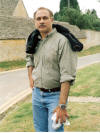|
|
the-south-asian.com July / August 2006 |
|
|||
|
August/September Contents
Sufis - wisdom against 50
years of mountain Heritage cities:
Cotton - the fibre of
|
|
||||
|
Page
1 of 2 TAXILA - 2002 by Salman Minhas
First published in October 2002
Taxila was one of the capitals of ancient kingdom of Gandhara – the other being Purushapura (later renamed Peshawar). Gandhara was the region, which, in present-day Pakistan, includes Peshawar, Dir, Swat, Bajaur and Bunair. The first known reference to the Gandhara region is found in the Rig Veda of 1200 BC. Later literature extols the splendour of Taxila ( Taksh-shila, as mentioned in the 6th century Buddhist texts) and its importance as a great centre of Buddhist learning.
Sir John Marshall was the Director General of the Archaeological Survey of British India from 1913 to 1934, and Sir Mortimer Wheeler continued the work in 1944. Pakistani archaeologists continued the work after 1947 and found that in addition to the Gandhara settlements of Taxila between the period 600 B.C. to 100 A.D, there were also the Neolithic settlements found in Taxila and in the areas of Mardan, Peshawar between the rivers of Indus and Kabul as they join at Attock. The classic Gandhara age – was the flowering of about 800 years of Indian, Persian , Greek, and Central Asian cultures .The city of Taxila is on the Grand Trunk [ GT] road about 30 miles from Islamabad & Rawalpindi. The remains of the old GT Road are still visible at a spot where one turns right towards Taxila going north near the railway line and the stone crushing plants that cause much of the haze over Islamabad’s pristine air.
Entering the Taxila area, one encounters the Armament factories and the Heavy Machinery Complex. These, and the University of Engineering and Technology are the salient features of Taxila . In addition, there are the beautiful, lush fruit and vegetable farms in the well watered valleys , the actual ruins, and the Taxila museum which Sir John Marshall built. Far beyond the ruins of the great Taxila university of the Gandhara period is the Atomic Energy complex. The farms these days are full of corn , cauliflower, carrots , while the oranges are still an unripe green. The oranges in the nearby groves at Khanpur are the famous red-blood variety and one can still go and pick these oranges. Loquat trees are also in plenty supply. The farms supply most of Islamabad and Rawalpindi with fruits and vegetables. The big dam at Khanpur supplies the water for these farms. Goats graze on the slopes of the small hills and in the glens in this area of Taxila among the ruins , near Sir John Marshalls hut at Jaulian where the old university ruins are . It could be a scene from Zorba – the Greek. At any moment one half expects o see a Zorba start to dance on the roof tops. But people here are Muslims, and as such more reserved . Standing at the ruins, Omar Khayyam’s poetry echoes in my ear . " They say the lion and the lizard ,keep the court, Where Jamshyd the great gloried and drank deep. And the wild ass stamps over his head , But cannot break his sleep ……."
Next time around, the other excavations around Taxila will be covered .Sirkup , Bhir mound, Sarai Khola, Hatial , Sirsukh, Dharma Rajika Stupa, Mohra Moradu and Jaulian – the University in more detail . This has been the first of a series of articles on Taxila & Gandhara civilization.
|
|||||
|
Copyright © 2000 - 2006 [the-south-asian.com]. Intellectual Property. All rights reserved. |
|||||




